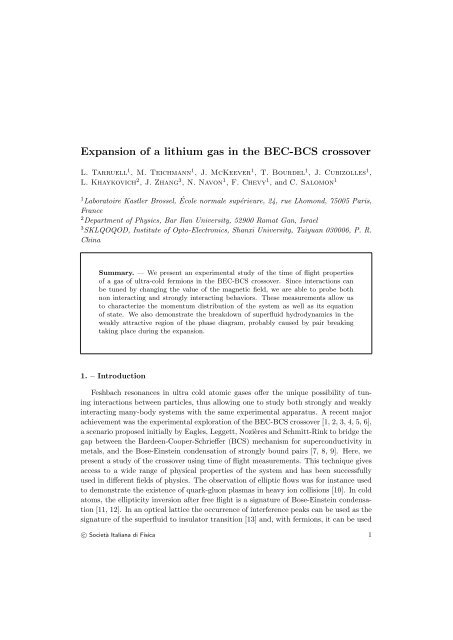Martin Teichmann Atomes de lithium-6 ultra froids dans la ... - TEL
Martin Teichmann Atomes de lithium-6 ultra froids dans la ... - TEL
Martin Teichmann Atomes de lithium-6 ultra froids dans la ... - TEL
Create successful ePaper yourself
Turn your PDF publications into a flip-book with our unique Google optimized e-Paper software.
Expansion of a <strong>lithium</strong> gas in the BEC-BCS crossover<br />
L. Tarruell 1 , M. <strong>Teichmann</strong> 1 , J. McKeever 1 , T. Bour<strong>de</strong>l 1 , J. Cubizolles 1 ,<br />
L. Khaykovich 2 , J. Zhang 3 , N. Navon 1 , F. Chevy 1 , and C. Salomon 1<br />
1Laboratoire Kastler Brossel, École normale supérieure, 24, rue Lhomond, 75005 Paris,<br />
France<br />
2Department of Physics, Bar I<strong>la</strong>n University, 52900 Ramat Gan, Israel<br />
3SKLQOQOD, Institute of Opto-Electronics, Shanxi University, Taiyuan 030006, P. R.<br />
China<br />
Summary. — We present an experimental study of the time of flight properties<br />
of a gas of <strong>ultra</strong>-cold fermions in the BEC-BCS crossover. Since interactions can<br />
be tuned by changing the value of the magnetic field, we are able to probe both<br />
non interacting and strongly interacting behaviors. These measurements allow us<br />
to characterize the momentum distribution of the system as well as its equation<br />
of state. We also <strong>de</strong>monstrate the breakdown of superfluid hydrodynamics in the<br />
weakly attractive region of the phase diagram, probably caused by pair breaking<br />
taking p<strong>la</strong>ce during the expansion.<br />
1. – Introduction<br />
Feshbach resonances in <strong>ultra</strong> cold atomic gases offer the unique possibility of tuning<br />
interactions between particles, thus allowing one to study both strongly and weakly<br />
interacting many-body systems with the same experimental apparatus. A recent major<br />
achievement was the experimental exploration of the BEC-BCS crossover [1, 2, 3, 4, 5, 6],<br />
a scenario proposed initially by Eagles, Leggett, Nozières and Schmitt-Rink to bridge the<br />
gap between the Bar<strong>de</strong>en-Cooper-Schrieffer (BCS) mechanism for superconductivity in<br />
metals, and the Bose-Einstein con<strong>de</strong>nsation of strongly bound pairs [7, 8, 9]. Here, we<br />
present a study of the crossover using time of flight measurements. This technique gives<br />
access to a wi<strong>de</strong> range of physical properties of the system and has been successfully<br />
used in different fields of physics. The observation of elliptic flows was for instance used<br />
to <strong>de</strong>monstrate the existence of quark-gluon p<strong>la</strong>smas in heavy ion collisions [10]. In cold<br />
atoms, the ellipticity inversion after free flight is a signature of Bose-Einstein con<strong>de</strong>nsation<br />
[11, 12]. In an optical <strong>la</strong>ttice the occurrence of interference peaks can be used as the<br />
signature of the superfluid to insu<strong>la</strong>tor transition [13] and, with fermions, it can be used<br />
c○ Società Italiana di Fisica 1

















